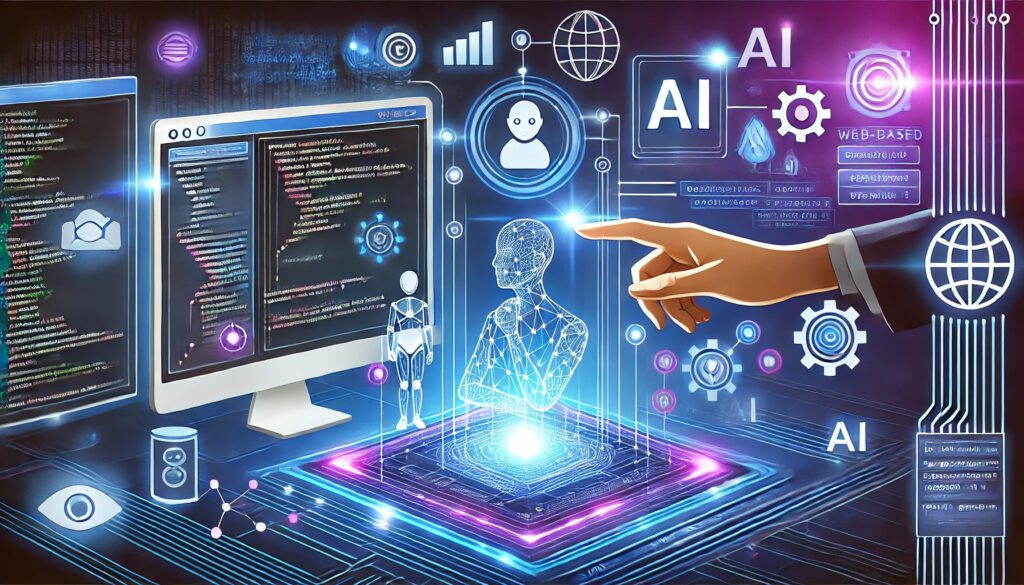
In the past, building a fully functional web-based software or app required years of coding experience and a team of skilled developers. Today, with the rapid advancements in Artificial Intelligence (AI), even those with minimal technical expertise can create software or apps that are scalable, functional, and impactful. AI-powered tools and no-code platforms have democratized app development, allowing entrepreneurs, small business owners, and creative individuals to turn their ideas into reality.
This comprehensive guide will walk you through the process of building a fully functional web-based software or app with the help of AI and minimal coding knowledge.
1. Why AI Is a Game-Changer for App Development
AI has revolutionized app development by simplifying traditionally complex processes:
- Automation: AI automates repetitive tasks, speeding up development.
- User-Friendly Tools: Platforms powered by AI eliminate the need for manual coding.
- Enhanced Functionality: AI adds advanced features like personalization, chatbots, and analytics.
- Cost-Effectiveness: Building apps with AI reduces the need for large development teams, lowering costs.
By leveraging AI, you can focus on the app’s design, usability, and functionality rather than worrying about the technical details.
2. Define Your Idea and Goals
Before starting, clearly outline what you want to achieve. Ask yourself:
- What problem will your software or app solve?
- Who is your target audience?
- What are the core features and functionalities?
Example:
If you’re creating a fitness app, decide whether it will focus on calorie tracking, workout routines, or AI-driven fitness coaching.
3. Choose the Right AI-Powered Tools
AI tools simplify app development, even for beginners. Here are some of the best options:
a. No-Code and Low-Code Platforms
- Bubble: Build web-based software with a drag-and-drop interface.
- Glide: Turn Google Sheets into mobile apps effortlessly.
- Adalo: Create fully functional apps with minimal effort.
b. AI Code Generators
- GitHub Copilot: Provides intelligent code suggestions for faster development.
- Tabnine: Offers AI-driven autocomplete for coding tasks.
c. AI-Powered APIs
- Google Cloud AI: Integrate machine learning and natural language processing.
- Microsoft Azure AI: Use tools for vision, language, and decision-making.
4. Plan Your App’s Structure and User Experience
To build a successful app, focus on creating a seamless user experience (UX). AI tools can assist in designing intuitive layouts and workflows.
Steps to Plan Your App:
- Sketch the User Journey: Map out how users will interact with your app.
- Create Wireframes: Use tools like Figma or Adobe XD for visual layouts.
- Leverage AI for UX Design: Platforms like Uizard generate app prototypes based on text inputs.
Pro Tip: Test your wireframes with potential users to gather feedback before development.
5. Develop Your App with AI Tools
Now that you have a clear plan, it’s time to bring your app to life.
a. Start with No-Code Platforms
For beginners, no-code platforms are the easiest way to create apps.
- Use Bubble to design web apps with a visual editor.
- Integrate data storage with platforms like Airtable or Firebase.
b. Add Advanced Features with AI APIs
- Image Recognition: Integrate Google Cloud Vision API.
- Personalization: Use machine learning tools to recommend content or products.
c. Use AI for Testing
AI-driven testing tools ensure your app is bug-free and user-friendly.
- Testim: Automates app testing.
- Applitools: Checks visual consistency across devices.
6. Integrate Data and Analytics
To make your app successful, data insights are crucial. AI can help you analyze user behavior, track performance, and optimize features.
Tools for Data Integration:
- Google Analytics: Monitor app traffic and user engagement.
- Mixpanel: Track user actions and retention rates.
- AI-Powered Insights: Use platforms like Amplitude for predictive analytics.
7. Deploy Your App
Once your app is built and tested, it’s time to make it live.
Web-Based Software:
- Host your app on platforms like AWS, Heroku, or Netlify.
- Use a custom domain for a professional look.
Mobile Apps:
- Publish on Google Play Store and Apple App Store.
- Ensure your app meets the guidelines of both platforms.
8. Market Your App for Maximum Reach
Even the most well-designed app needs effective marketing to succeed.
SEO Strategies:
- Optimize your app description with keywords like “AI-powered app development” and “no-code app creation.”
- Create a blog post (like this one!) that explains how your app solves user problems.
Social Media Campaigns:
- Share your app’s features and success stories on Instagram, LinkedIn, and Twitter.
- Collaborate with influencers for promotions.
Content Marketing:
- Publish tutorials or case studies showcasing how your app works.
- Start a YouTube channel or podcast to engage with your audience.
9. Monetize Your App
To turn your app into a revenue stream, consider these strategies:
- Freemium Model: Offer basic features for free and charge for premium ones.
- In-App Purchases: Add value with extra features or content.
- Subscription Plans: Provide access to advanced tools for a monthly fee.
10. Keep Improving Your App
Building a successful app is an ongoing process. Use AI tools to:
- Gather Feedback: Use surveys or reviews to understand user needs.
- Analyze Trends: Stay updated with the latest industry trends and features.
- Release Updates: Regularly add new functionalities and fix bugs.
Case Studies: AI-Driven Success Stories
1. Grammarly
An AI-powered writing assistant that started as a simple browser extension and is now used by millions worldwide.
2. Canva
With AI-driven templates and design tools, Canva has become a favorite among non-designers.
3. Duolingo
Uses AI to personalize language-learning experiences, making education accessible and engaging.
Conclusion: Build Your App Today
Thanks to AI, creating fully functional web-based software or a useful app is no longer out of reach for non-coders. With the right tools, planning, and a clear vision, you can bring your ideas to life and reach a global audience.
Whether you’re solving a specific problem, launching a business, or exploring a creative project, AI-powered development tools offer the perfect starting point. Start building today and bring your app idea to life—because the world isn’t just waiting; it’s ready for the next revolutionary platform, the next Facebook, Amazon, Gmail or YouTube that will redefine how we live, connect, and innovate!
